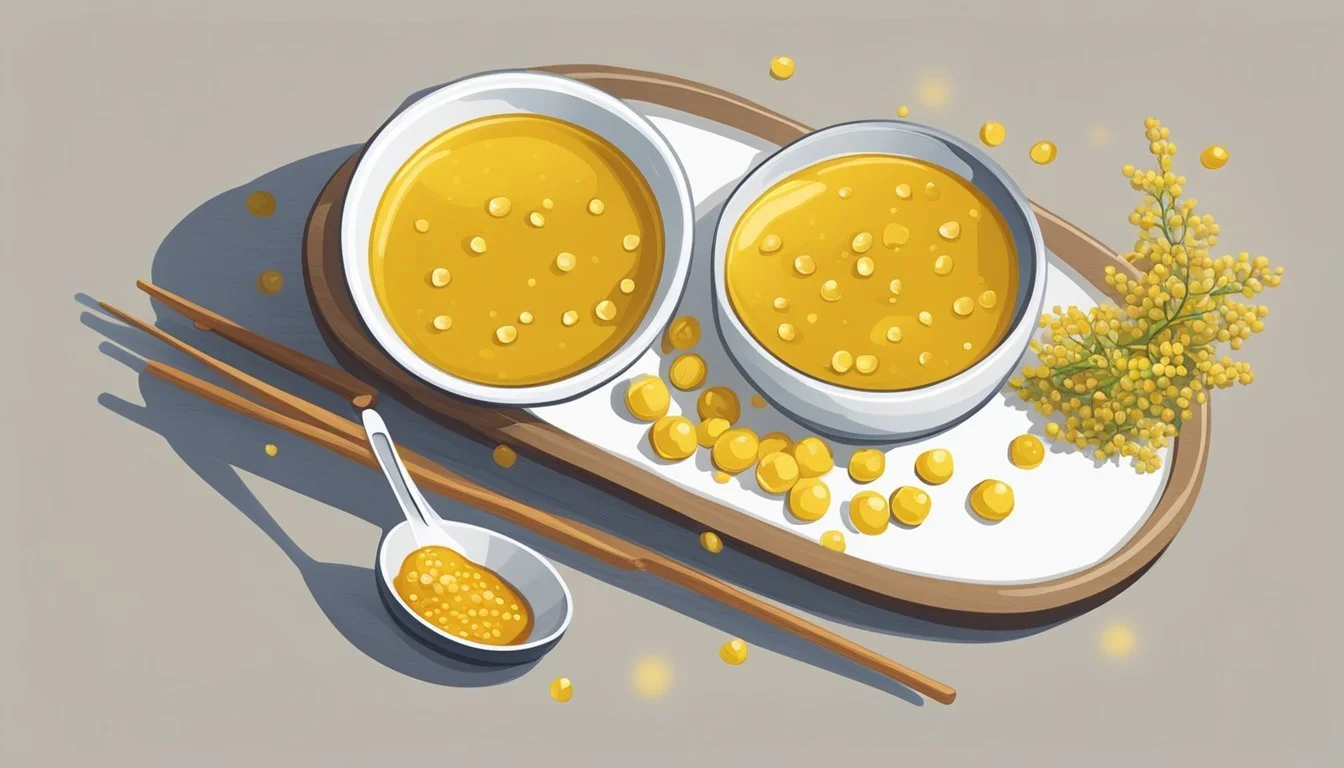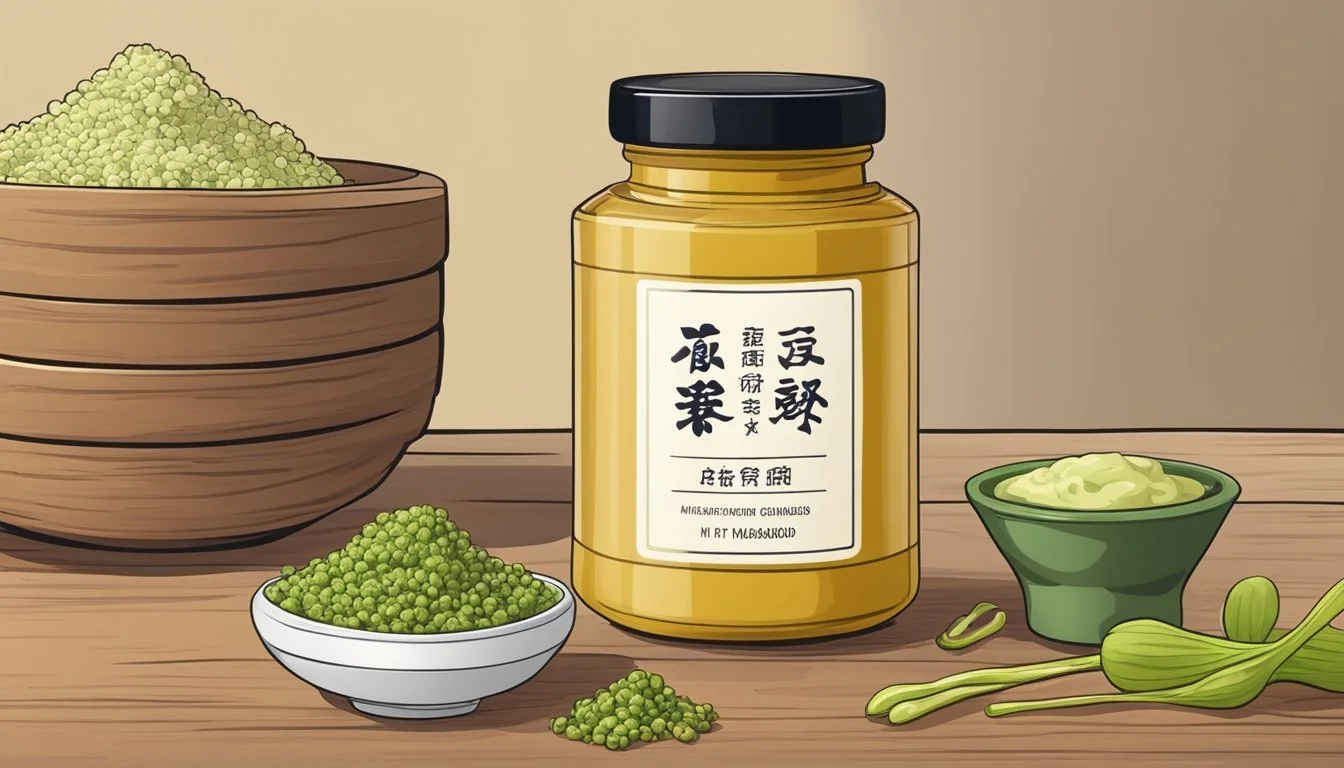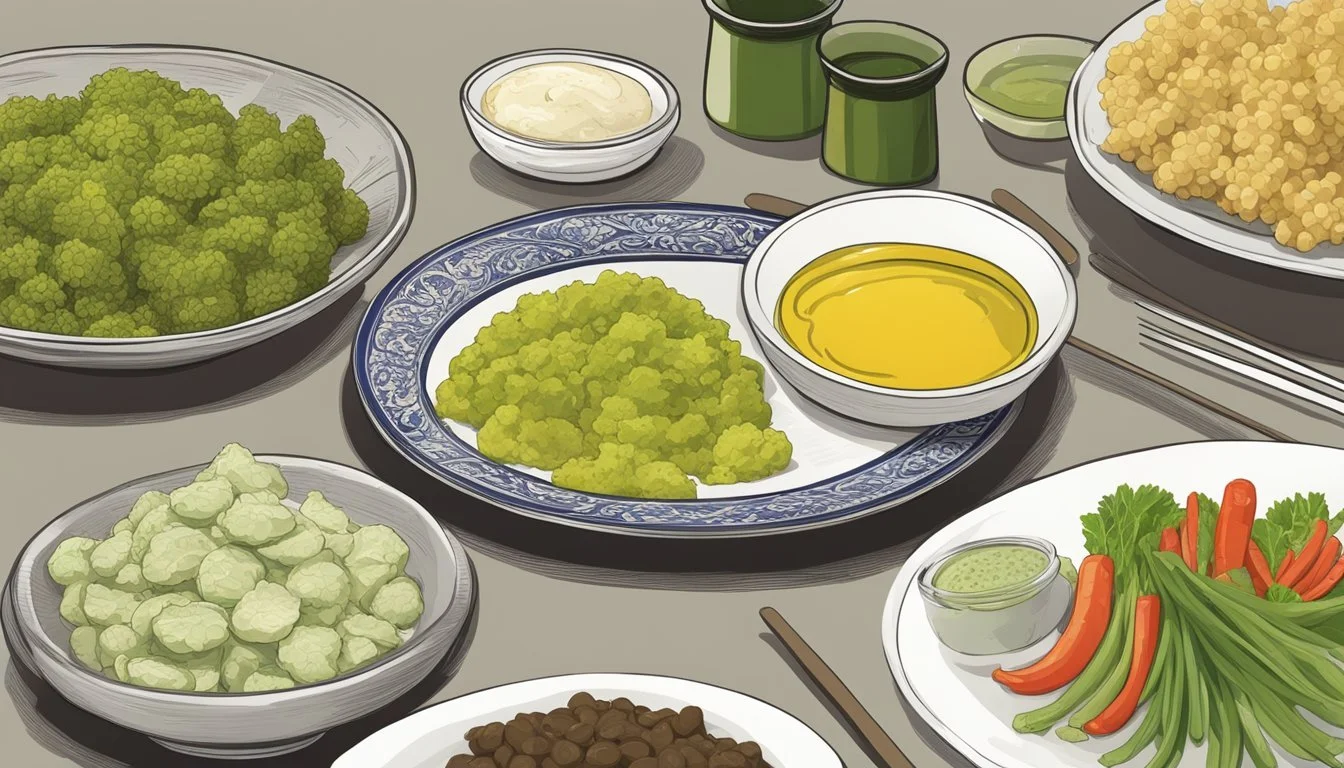Chinese Hot Mustard Substitutes
Best Alternatives for Your Dishes
Chinese hot mustard is a condiment that stands out for its sharp, pungent flavor, immediately recognizable in many Asian cuisines. Traditionally made from a simple mix of dry mustard powder and water, it delivers a significant kick of heat to dishes. Its distinct taste is sometimes enhanced with ingredients like sesame oil, rice vinegar, or turmeric, tailoring it to various flavor profiles typical in Chinese cooking.
When the authentic ingredient is unavailable, several substitutes can effectively mimic the heat and tang of Chinese hot mustard. English mustard, made from both brown and white mustard seeds, is a readily accessible alternative that can closely replicate the desired intensity. Other options include spicy brown mustard, which includes an American twist with vinegar, or wasabi and horseradish, which, while differing in origin, share a similar bite. Homemade versions using dry mustard powder and water can also serve as a quick and easy replacement, providing cooks with the flexibility to adjust the strength to their preference.
Navigating through the available options, cooks can achieve a comparable flavor and heat to Chinese hot mustard in their dishes. This adaptability ensures that the characteristic warmth and zest of the condiment are preserved, maintaining the integrity of the traditional taste experience.
Understanding Chinese Hot Mustard
Chinese hot mustard offers a spicy, sinus-clearing kick renowned in many Asian cuisines, especially within Chinese restaurants. It's characterized by a sharp, potent flavor that can add depth and intensity to a variety of dishes.
Primary Ingredient:
Mustard Powder: This is the foundation of Chinese hot mustard and is ground from brown mustard seeds.
Activation Process:
Enzyme Activation: The enzyme myrosinase is activated when mustard powder is mixed with cold water. This chemical reaction develops the trademark heat.
Texture and Consistency:
Chinese hot mustard typically has a paste-like consistency. Over time, the mixture may thicken or thin, but it should initially be combined to a smooth, creamy texture.
Flavor Profile:
The spicy flavor and heat are what make Chinese hot mustard stand out. It has a sinus-clearing effect that is both appreciated and sought after for certain recipes.
Preparation Method:
To prepare, one mixes dry mustard powder with cold water and allows it to rest. The resting time—ranging from 10 to 45 minutes—is essential for the spicy flavors to develop fully.
Usage:
It is often used as a condiment or in marinades, providing a heat that supports other flavors rather than overshadowing them.
In summary, Chinese hot mustard is not just about the spicy sensation it brings, but also about the complexity and depth of flavor it adds to culinary creations. Understanding its components and preparation is key to using it effectively in cooking.
Common Chinese Hot Mustard Substitutes
When looking for alternatives to Chinese hot mustard, one should consider the flavor profile and heat level the substitution will bring to the dish.
Horseradish and Its Variations
Horseradish, a root vegetable known for its pungent taste and fiery flavor, serves as an excellent substitute. It can be used in its pure, grated form or as a prepared condiment. Variations of horseradish, including those mixed with beetroot for color, can also work when a pinch of sharpness is desired in recipes calling for Chinese hot mustard.
Wasabi: The Japanese Alternative
Wasabi, the Japanese condiment typically associated with sushi, provides a similar heat and nose-tingling sensation to Chinese hot mustard. Real wasabi or wasabi paste, when mixed with water, can adequately offer the sharpness required, although the flavor is distinct and it may impart a greenish hue.
Mustard Seeds and Mustard Powder
The foundation of Chinese hot mustard lies in the mustard seeds. Both brown and yellow mustard seeds, ground into powder, are viable substitutes when mixed with water. This concoction activates the enzyme myrosinase, causing a reaction that produces the desired heat.
English Mustard
English mustard, made from both brown and white mustard seeds, stands as a close alternative, bringing a strong heat that somewhat resembles Chinese hot mustard. Adjust the quantity according to taste, as it can be nearly as potent.
Dijon Mustard
Dijon mustard, though milder and less piquant than Chinese hot mustard, can still be used as a substitute, especially in dressings or marinades. The inclusion of white wine in Dijon mustard contributes to a different flavor profile but can provide the desired tanginess in the absence of the authentic condiment.
Flavor Profiles and Culinary Uses
The flavor profile of Chinese hot mustard is distinct with a bold, pungent, and horseradish-like heat that awakens the taste buds. Its heat is more akin to that of wasabi, offering a quick and potent sinus-clearing effect. This heat comes from enzymes activated upon mixing the ground mustard seeds with cold water. Chinese hot mustard often serves as a dipping sauce, delivering intensity that complements a variety of appetizers (What wine goes well with appetizers?).
Common appetizers paired with Chinese hot mustard include:
Wontons
Spring Rolls
Egg Rolls
In terms of its culinary uses, Chinese hot mustard is typically used sparingly due to its strong flavor. It can be employed as a condiment or incorporated into a recipe for a kick of heat and tanginess. Its robust taste makes it an ideal accompaniment to meats, particularly roasted pork, enhancing the flavors without overwhelming the dish.
Consider these culinary uses for Chinese hot mustard:
Dip: A small bowl of Chinese hot mustard can be offered alongside appetizers for dipping.
Sauce: Mixing with other ingredients, such as duck sauce, elevates the complexity of flavors in a dish.
Glaze or Marinades: A little can be brushed over meats before cooking to infuse them with a spicy tang.
Since Chinese hot mustard can differ in intensity, it's wise for cooks to adjust the amount used to suit the desired level of heat. Spicy brown mustard and preparations with a similar heat level, like English mustard, provide alternative options that maintain the desired tanginess and pungency within recipes.
Homemade Substitutes for Chinese Hot Mustard
Creating a substitute for Chinese hot mustard at home is a straightforward process. It involves mixing mustard powders or grinding mustard seeds, with just a few household ingredients to mimic the fiery taste and texture.
Mixing Mustard Powders
Using dry mustard powder, one can mix a simple homemade version of Chinese hot mustard. A basic recipe could include:
1 teaspoon of dry mustard powder
2 teaspoons of cold water
A few drops of neutral oil like vegetable or canola
A small splash of rice vinegar for tanginess
To prepare, combine the mustard powder and water to activate the enzyme myrosinase, which release the heat elements. Then, blend in the oil and vinegar to achieve a smooth consistency. This improvised mustard may mimic the texture and the sharpness of the traditional condiment with a balance of protein and fiber, while keeping the calories and fat negligible. The absence of additives also means control over the salt and other ingredients.
Creating Mustard with Seeds
For those who prefer starting from scratch, mustard seeds can be ground into powder form using a spice grinder or mortar and pestle. Begin with:
1/4 cup of brown mustard seeds (approximate fiber: 6.4g and protein: 5.1g per serving)
1/4 cup of cold water to adjust texture
A pinch of salt for flavor enhancement
Grind the mustard seeds finely, then mix with cold water to initiate the enzymatic reaction of myrosinase, lending the homemade mustard its potency. Add a pinch of salt to enhance its flavor profile. For those monitoring their intake, this method affords complete control over the amount of fat and calories in the mixture. The consistency may be altered by adding more or less water to preference.
Substitute Considerations for Health and Dietary Restrictions
When selecting a substitute for Chinese hot mustard, one should be aware of health and dietary concerns that could influence their choice. Particularly for individuals with gluten intolerance, opting for a gluten-free alternative such as English mustard is crucial, as some mustards may contain gluten through added thickeners or preservatives.
For those following a vegan or vegetarian diet, verifying the ingredients list for animal derivatives is key. Mustard itself is typically plant-based, but certain brands might add honey or other non-vegan components. In such cases, individuals may look for certified vegan products to ensure the condiment aligns with their dietary principles.
Nutrient Profile
Substitutes can vary significantly in their nutritional content. Consider the following:
Calories: Some substitutions may have higher caloric content, affecting those monitoring calorie intake.
Protein & Fiber: Alternatives like tahini offer additional protein and fiber.
Fat: Replacement options, such as mayonnaise, can have increased fat content, important for those managing fat consumption.
Substitute Gluten-Free Vegan Vegetarian Calories Protein Fiber Fat English Mustard Yes Yes Yes Low Moderate Low Low Tahini Yes Yes Yes Moderate High High High Mayonnaise Often No Yes High Low Low High
Individuals with allergies must ensure their mustard replacement doesn’t contain allergens like eggs, which are present in some mayonnaise, or other ingredients they are sensitive to. Understanding the chemical reaction that causes the heat in mustards, which comes from enzymes reacting with the compounds in mustard seeds, can also be beneficial. Substitutes that don’t rely on this reaction might provide a different sensory experience.
Lastly, while not typically a concern for condiments, those looking to reduce starch in their diet should be wary of substitutes that use starch as a thickening agent.
Where to Find Substitutes
When searching for a substitute for Chinese hot mustard, consumers have several options. The choice of substitute depends on the desired heat level and flavor profile. Here is a breakdown of where one can find suitable replacements:
Grocery Stores:
Most local grocery stores carry a range of mustards. Look for English mustard, which is known for its hot and robust flavor, making it a close alternative to Chinese hot mustard.
Premade Condiments Section:
Dijon Mustard (milder but workable)
Asian Grocery Stores:
These specialty shops are ideal for finding authentic condiments. They might stock Wasabi or Wagarashi, a Japanese-style mustard that may be used in place of Chinese hot mustard for that spicy kick.
Online Retailers:
For those looking for convenience or hard-to-find items, online stores can be a valuable resource. Websites may offer a range of spicy condiments, including premade Chinese hot mustard or its substitutes.
Here's a quick reference:
Substitute Location Notes English Mustard Grocery Store, Online Very hot, similar heat. Wasabi Asian Grocery Store, Online Much stronger, use sparingly. Spicy Brown Mustard Grocery Store Includes vinegar, American variant. Wagarashi Asian Grocery Store Japanese equivalent. Dijon Mustard Grocery Store Milder, but a suitable substitute.
Consumers should remember that the heat and flavor of Chinese hot mustard are quite unique, so substitutes may not provide an identical taste experience but can serve as a satisfactory replacement in a pinch.
Storage and Shelf Life
When considering the substitutes for Chinese hot mustard, it is essential to discuss how to store them and their shelf life. Proper storage is key to maintaining the potency and flavor of these substitutes.
Dry Mustard:
A popular option is dry mustard, which is a powder made from ground mustard seeds. It's known for longevity if stored correctly.
Storage: Keep it in a cool, dry place away from heat and light. An airtight container is recommended to prevent moisture from deactivating the enzymes that contribute to its heat.
Shelf Life: At room temperature, dry mustard can last up to two years. Its indefinite shelf life in the fridge makes it a reliable substitute.
English Mustard:
Another substitute is English mustard, which is commonly used due to its similar heat profile.
Storage: Keeping this type of mustard in the fridge after opening is imperative to prevent degradation.
Shelf Life: Unopened, it may last up to three years. Once opened and refrigerated, the shelf life may range from one to two years.
Key Pointers:
For both, it is crucial to check for any alterations in smell, texture, or taste over time, which can indicate spoilage.
Avoid direct sunlight and heat as these can accelerate the breakdown of essential compounds.
Storage vessels should always be clean to minimize the risk of introducing contaminants.
Managing these elements ensures that substitutes for Chinese hot mustard retain their quality and remain a robust, flavorful addition to various dishes.
Creative Uses Beyond Traditional Pairings
Chinese hot mustard typically accompanies appetizers like crab rangoon and fried wonton. However, this bold condiment can be reimagined in various dishes beyond its usual pairings. Enthusiasts may experiment by mixing a dollop of Chinese hot mustard into dips for a fiery kick. This can elevate the flavors of even the most simplistic takeout.
Fusion Cuisine: For an unconventional approach, one could blend Chinese hot mustard with sweet components such as honey or duck sauce. This fusion creates a sweet and spicy glaze perfect for brushing onto grilled items or drizzling over fried noodles.
Vinaigrettes and Marinades:
Vinegar: Combine Chinese hot mustard with rice vinegar or wine vinegar to craft a zesty vinaigrette.
Oil: Mix with vegetable oil and a hint of soy sauce for an Asian-inspired salad dressing.
Marinade: Pair with rice wine or white wine to marinate meats, offering a tangy taste that is both aromatic and flavorsome.
When utilizing Chinese hot mustard in these innovative ways, they should consider the intensity of the mustard and balance it with complementary flavors like ginger to enhance the overall taste profile without overpowering the dish.
Additionally, chefs may incorporate Chinese hot mustard into fried foods batter for an unexpected pop of heat. Yet, it's essential to use it sparingly to ensure it enhances rather than dominates the taste.
Through these creative uses, Chinese hot mustard transcends its traditional role, promising a dynamic and versatile addition to a myriad of culinary creations.








